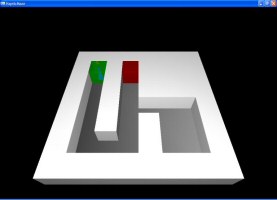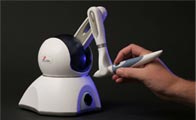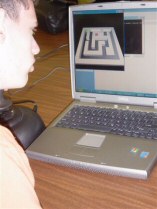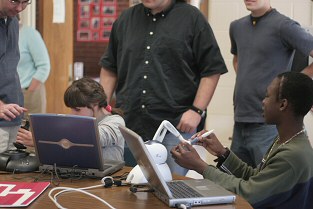AMaze
Enabling Technology 2005
Megan, Michael, David, Michael

What are we doing?
Our group has decided to assist persons who are visually impaired by creating a virtual maze program. We hope that improving spatial awareness through this program will enable the transfer of this skill into the real world. For example, in the future we will be able to provide students who are blind with a map of their school. These students will hopefully feel a lot more comfortable knowing the building they are going to enter before they actually have to enter it themselves. In our aMaze program, we incorporate the Sensable Phantom Device as well as a Microsoft SideWinder Force Feedback 2 Joystick to enable the user to experience feedback from the program. This feedback is used as a guide in the virtual maze, and should aid in completing real mazes that we set up for the students. The maze can also be navigated using the keyboard in the absence of an available haptic device. 3D spatial audio is used to give additional feedback for navigating the maze. Here are pictures of the interface devices we support:
The Supported Interface Devices:



What we have accomplished:
- Been awarded an APPLES grant – you can see a congrats to us on the APPLES website: http://www.unc.edu/apples
- Implemented the aMaze Program
- Added keyboard, Joystick, and Phantom interfaces
- Added 3D spatial audio
- Added intuitive, user-friendly maze editor.
- Field tested aMaze at two different schools
- Submitted a paper to ASSETS 2005 (Will be made available after the review process is complete)
- Demonstrated our program at Maze Day
Who we are working with
Diane Brauner has been a huge help in giving us ideas and feedback on the aMaze program. She also set up some field tests at a couple of local schools which were very helpful in refining our program.
Demos at C.W. Stanford Middle School and Governor Morehead School:


Maze Day
On Maze Day, April 27th, 2005, 51 visually impaired students and 55 adults visited the computer science department to demo various programs designed for visually impaired individuals that were developed at UNC-Chapel Hill. The aMaze team had a station with 3 computers, one with a keyboard, one with the joystick, and one with the phantom. We also had a real maze (complete with wolf and elephant sound sources) constructed in a room that matched one of the virtual mazes that were being shown. By navigating the maze using the computer beforehand, the general consensus was that it was much easier to navigate the real maze. Maze Day was a lot of fun, and we were proud to be a part of it. A powerpoint presentation of Maze Day pictures is available here .
Presentation
Here is a link to our class Presentation .
Implementation Details
The aMaze program was writtin in C++, using GLUT/OpenGL, FMod, zlib, the Sensable Open Haptics library, DirectX, and the Microsoft Speech API. The maze editor was written in Delphi.
aMaze Features:
- Mazes of arbitrary size on a square grid
- 3D spatial audio
- Naming map regions, with hint button to tell where the player currently is
- Ambient 3D spatial sound cues
- Audio simulation of a cane sweeping the environment to give cues about the placement of walls
- Fully accessible menu system, using audio
- Support for keyboard, joystick, and phantom navigation
Downloads:
The current source code is available here . The current binaries are avialable here . There are debug and release copies of both the phantom and non-phantom versions. These are a snapshot as of Maze Day. The code is in a little bit of disarray right now, but will be fixed in the near future. Use at your own risk.